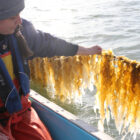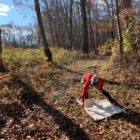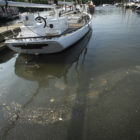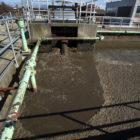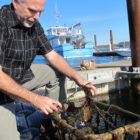Environmental Health
Looking To Bolster The Environment And The Economy, Farmers And Scientists Cultivate A Viable Kelp Industry
|
On a gray morning in late April, Suzie Flores, 40, the owner of Stonington Kelp Co., hustled out of her hybrid Highlander in a Westport parking lot. She grabbed a couple of coolers of freshly harvested Connecticut sugar kelp from her SUV, then dashed to the rear entrance of a posh restaurant to deposit 60 pounds or so of seaweed. Because the weather was breaking—for the better, for once—she hoped to hightail it back to Stonington to help her husband, Jay Douglas, work his barge on the Pawcatuck River before their weather window closed. The climate, it’s changing, and this has wreaked havoc on Connecticut’s fledgling kelp harvest this year. Waters too warm delayed finding wild kelp seed in the ocean last fall.
